Detailed explanation of string functions in MySQL
I saw a question about mysql in the forum today. The question is as follows
good_id cat_id
12654 665,569
12655 601,4722
goods_id is the product id
cat_id is the classification id
How do I check the data based on this classification ID (a product has multiple categories, separated by commas)
I am using like now. In this case, entering a classification id is This product can be found by entering 688 or 4722, but the product can also be found by inputting 722.
If you use like, there will definitely be problems. My initial idea is to replace the string in cat_id with an array, so that the in operation in mysql can be used. In this way, search 722 will not appear, and all products under the 4722 category will appear. I searched for a long time on the Internet, but I couldn't find any string operation function in this area. However, I found that although the find_in_set function cannot convert a string into an array, the above situation will not occur. I found that there were many functions that I didn't know, so I collected them from the manual and the Internet for a long time and made some examples.
CHAR_LENGTH(str) Returns the number of characters in str





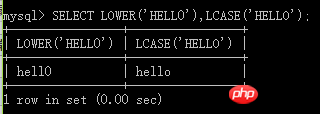

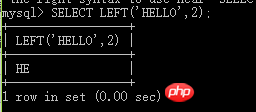
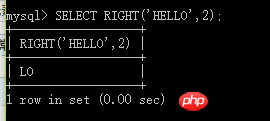



 ##REPEAT(s,n) returns a string composed of n s, n<=0, returns empty; s or n is NULL, returns NULL
##REPEAT(s,n) returns a string composed of n s, n<=0, returns empty; s or n is NULL, returns NULL
 SPACE(n) Returns n space strings
SPACE(n) Returns n space strings
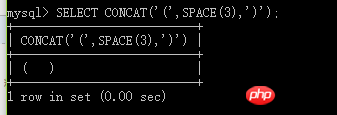 REPLACE(s,s1,s2) Returns --replacing s with s2 The result of all s1 strings
REPLACE(s,s1,s2) Returns --replacing s with s2 The result of all s1 strings
##STRCPM(s1,s2) s1==s2 returns 0 s1 SUBSTRING(s,n,len), MID(s,n,len) returns a string of len length starting from n. If n<0, it starts from the last reciprocal of s. Start intercepting n characters. If n=0, an empty string will be returned; len can be omitted - all characters after n will be intercepted LOCATE(str1, str2), POSITION(str1 IN str2), INSTR(str2, str1) Return the starting position of str1 in str2 REVERSE(s) Returns the reverse of the string of s ELT(n,str1,str2, str3...) Returns the nth string in str1, str2.., if n exceeds return null FIELD(s,str1,str2,str3.. ..) Returns the position of the first occurrence of s in str1, str2..., without returning 0 FIND_IN_SET(s,str1) Returns the position of s in The position of occurrence in str1, where str1 consists of multiple strings, a comma-separated list The above is the detailed content of Detailed explanation of string functions in MySQL. For more information, please follow other related articles on the PHP Chinese website!




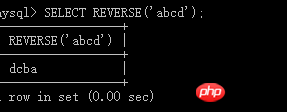




Hot AI Tools

Undresser.AI Undress
AI-powered app for creating realistic nude photos

AI Clothes Remover
Online AI tool for removing clothes from photos.

Undress AI Tool
Undress images for free

Clothoff.io
AI clothes remover

Video Face Swap
Swap faces in any video effortlessly with our completely free AI face swap tool!

Hot Article

Hot Tools

Notepad++7.3.1
Easy-to-use and free code editor

SublimeText3 Chinese version
Chinese version, very easy to use

Zend Studio 13.0.1
Powerful PHP integrated development environment

Dreamweaver CS6
Visual web development tools

SublimeText3 Mac version
God-level code editing software (SublimeText3)

Hot Topics
 1659
1659
 14
14
 1416
1416
 52
52
 1310
1310
 25
25
 1258
1258
 29
29
 1232
1232
 24
24
 MySQL's Role: Databases in Web Applications
Apr 17, 2025 am 12:23 AM
MySQL's Role: Databases in Web Applications
Apr 17, 2025 am 12:23 AM
The main role of MySQL in web applications is to store and manage data. 1.MySQL efficiently processes user information, product catalogs, transaction records and other data. 2. Through SQL query, developers can extract information from the database to generate dynamic content. 3.MySQL works based on the client-server model to ensure acceptable query speed.
 Laravel Introduction Example
Apr 18, 2025 pm 12:45 PM
Laravel Introduction Example
Apr 18, 2025 pm 12:45 PM
Laravel is a PHP framework for easy building of web applications. It provides a range of powerful features including: Installation: Install the Laravel CLI globally with Composer and create applications in the project directory. Routing: Define the relationship between the URL and the handler in routes/web.php. View: Create a view in resources/views to render the application's interface. Database Integration: Provides out-of-the-box integration with databases such as MySQL and uses migration to create and modify tables. Model and Controller: The model represents the database entity and the controller processes HTTP requests.
 How to start mysql by docker
Apr 15, 2025 pm 12:09 PM
How to start mysql by docker
Apr 15, 2025 pm 12:09 PM
The process of starting MySQL in Docker consists of the following steps: Pull the MySQL image to create and start the container, set the root user password, and map the port verification connection Create the database and the user grants all permissions to the database
 Solve database connection problem: a practical case of using minii/db library
Apr 18, 2025 am 07:09 AM
Solve database connection problem: a practical case of using minii/db library
Apr 18, 2025 am 07:09 AM
I encountered a tricky problem when developing a small application: the need to quickly integrate a lightweight database operation library. After trying multiple libraries, I found that they either have too much functionality or are not very compatible. Eventually, I found minii/db, a simplified version based on Yii2 that solved my problem perfectly.
 MySQL and phpMyAdmin: Core Features and Functions
Apr 22, 2025 am 12:12 AM
MySQL and phpMyAdmin: Core Features and Functions
Apr 22, 2025 am 12:12 AM
MySQL and phpMyAdmin are powerful database management tools. 1) MySQL is used to create databases and tables, and to execute DML and SQL queries. 2) phpMyAdmin provides an intuitive interface for database management, table structure management, data operations and user permission management.
 MySQL vs. Other Programming Languages: A Comparison
Apr 19, 2025 am 12:22 AM
MySQL vs. Other Programming Languages: A Comparison
Apr 19, 2025 am 12:22 AM
Compared with other programming languages, MySQL is mainly used to store and manage data, while other languages such as Python, Java, and C are used for logical processing and application development. MySQL is known for its high performance, scalability and cross-platform support, suitable for data management needs, while other languages have advantages in their respective fields such as data analytics, enterprise applications, and system programming.
 Laravel framework installation method
Apr 18, 2025 pm 12:54 PM
Laravel framework installation method
Apr 18, 2025 pm 12:54 PM
Article summary: This article provides detailed step-by-step instructions to guide readers on how to easily install the Laravel framework. Laravel is a powerful PHP framework that speeds up the development process of web applications. This tutorial covers the installation process from system requirements to configuring databases and setting up routing. By following these steps, readers can quickly and efficiently lay a solid foundation for their Laravel project.
 MySQL vs. Other Databases: Comparing the Options
Apr 15, 2025 am 12:08 AM
MySQL vs. Other Databases: Comparing the Options
Apr 15, 2025 am 12:08 AM
MySQL is suitable for web applications and content management systems and is popular for its open source, high performance and ease of use. 1) Compared with PostgreSQL, MySQL performs better in simple queries and high concurrent read operations. 2) Compared with Oracle, MySQL is more popular among small and medium-sized enterprises because of its open source and low cost. 3) Compared with Microsoft SQL Server, MySQL is more suitable for cross-platform applications. 4) Unlike MongoDB, MySQL is more suitable for structured data and transaction processing.




